Microspheres Formation in a Glass–Metal Hybrid Fiber System: Application in Optical Microwires
Abstract
:1. Introduction
2. Materials and Methods
3. Results and Discussion
3.1. Instability Analysis of Heated Microwires
3.2. Simulation Studies
3.2.1. Effect of Temperature
3.2.2. Effect of Core Radius
3.2.3. Effect of the Width and Wavelength of Perturbations
3.2.4. Simulation of the Tapering Process
4. Conclusions
Author Contributions
Funding
Acknowledgments
Conflicts of Interest
References
- Challener, W.A.; Peng, C.; Itagi, A.V.; Karns, D.; Peng, W.; Peng, Y.; Yang, X.; Zhu, X.; Gokemeijer, N.J.; Hsia, Y.-T.; et al. Heat-assisted magnetic recording by a near-field transducer with efficient optical energy transfer. Nat. Photonics 2009, 3, 220–224. [Google Scholar] [CrossRef]
- Bauch, M.; Toma, K.; Toma, M.; Zhang, Q.; Dostalek, J. Plasmon-Enhanced Fluorescence Biosensors: A Review. Plasmonics 2014, 9, 781–799. [Google Scholar] [CrossRef] [PubMed]
- Petropoulou, A.; Zervas, M.N.; Riziotis, C. Design optimization of gold-coated fiber tips with embedded plasmonic slot nanoresonators. J. Opt. 2017, 19, 055002. [Google Scholar] [CrossRef]
- Gholipour, B.; Nalla, V.; Bastock, P.; Khan, K.; Craig, C.; Hewak, D.W.; Zheludev, N.I.; Soci, C. Plasmonic Nanowire Continuum Light Source. In Proceedings of the 2014 Conference on Lasers and Electro-Optics (cleo), San Jose, CA, USA, 2 June 2014; IEEE: New York, NY, USA, 2014. [Google Scholar]
- Alchalaby, A.; Lwin, R.; Al-Janabi, A.H.; Trimby, P.W.; Fleming, S.C.; Kuhlmey, B.T.; Argyros, A. Investigation of Plateau–Rayleigh Instability in Drawn Metal–Polymer Composite Fibers for Metamaterials Fabrication. J. Lightw. Technol. 2016, 34, 2198–2205. [Google Scholar] [CrossRef]
- Petropoulou, A.; Antonopoulos, G.; Bastock, P.; Kakarantzas, G.; Craig, C.; Hewak, D.W.; Zervas, M.N.; Riziotis, C. All-Fiber Plasmonic Platform Based on Hybrid Composite Metal/Glass Microwires. J. Phys. Chem. C 2018, 122, 26169–26176. [Google Scholar] [CrossRef] [Green Version]
- Petropoulou, A.; Antonopoulos, G.; Bastock, P.; Craig, C.; Kakarantzas, G.; Hewak, D.W.; Zervas, M.N.; Riziotis, C. Robust plasmonic tips fabricated by the tapering of composite hybrid silicate microfibers with metallic core. In Plasmonics II; Xu, H., Kawata, S., Bergman, D.J., Zhu, X., Eds.; SPIE-Int Soc Optical Engineering: Bellingham, WA, USA, 2016; Volume 10028, p. UNSP 100280N. ISBN 978-1-5106-0475-9. [Google Scholar]
- Bastock, P. Manufacturing Novel Fibre. Ph.D. Thesis, Optoelectronics Research Centre, University of Southampton, Southampton, UK, 2015. [Google Scholar]
- Karim, S.; Toimil-Molares, M.E.; Balogh, A.G.; Ensinger, W.; Cornelius, T.W.; Khan, E.U.; Neumann, R. Morphological evolution of Au nanowires controlled by Rayleigh instability. Nanotechnology 2006, 17, 5954–5959. [Google Scholar] [CrossRef]
- Toimil-Molares, M.E.; Balogh, A.G.; Cornelius, T.W.; Neumann, R.; Trautmann, C. Fragmentation of nanowires driven by Rayleigh instability. Appl. Phys. Lett. 2004, 85, 5337–5339. [Google Scholar] [CrossRef]
- Aktas, O.; Ozgur, E.; Tobail, O.; Kanik, M.; Huseyinoglu, E.; Bayindir, M. A New Route for Fabricating On-Chip Chalcogenide Microcavity Resonator Arrays. Adv. Opt. Mater. 2014, 2, 618–625. [Google Scholar] [CrossRef] [Green Version]
- Deng, D.S.; Nave, J.-C.; Liang, X.; Johnson, S.G.; Fink, Y. Exploration of in-fiber nanostructures from capillary instability. Opt. Express 2011, 19, 16273–16290. [Google Scholar] [CrossRef]
- Deng, D.S.; Orf, N.D.; Abouraddy, A.F.; Stolyarov, A.M.; Joannopoulos, J.D.; Stone, H.A.; Fink, Y. In-Fiber Semiconductor Filament Arrays. Nano Lett. 2008, 8, 4265–4269. [Google Scholar] [CrossRef] [Green Version]
- Deng, D.S.; Orf, N.D.; Danto, S.; Abouraddy, A.F.; Joannopoulos, J.D.; Fink, Y. Processing and properties of centimeter-long, in-fiber, crystalline-selenium filaments. Appl. Phys. Lett. 2010, 96, 023102. [Google Scholar] [CrossRef] [Green Version]
- Gumennik, A.; Wei, L.; Lestoquoy, G.; Stolyarov, A.M.; Jia, X.; Rekemeyer, P.H.; Smith, M.J.; Liang, X.; Grena, B.J.-B.; Johnson, S.G.; et al. Silicon-in-silica spheres via axial thermal gradient in-fibre capillary instabilities. Nat. Commun. 2013, 4, 2216. [Google Scholar] [CrossRef] [PubMed]
- Kaufman, J.J.; Tao, G.; Shabahang, S.; Banaei, E.-H.; Deng, D.S.; Liang, X.; Johnson, S.G.; Fink, Y.; Abouraddy, A.F. Structured spheres generated by an in-fibre fluid instability. Nature 2012, 487, 463–467. [Google Scholar] [CrossRef] [PubMed]
- Tao, G.; Kaufman, J.J.; Shabahang, S.; Naraghi, R.R.; Sukhov, S.V.; Joannopoulos, J.D.; Fink, Y.; Dogariu, A.; Abouraddy, A.F. Digital design of multimaterial photonic particles. Proc. Natl. Acad. Sci. USA 2016, 113, 6839–6844. [Google Scholar] [CrossRef] [PubMed] [Green Version]
- Qin, Y.; Lee, S.-M.; Pan, A.; Gosele, U.; Knez, M. Rayleigh-instability-induced metal nanoparticle chains encapsulated in nanotubes produced by atomic layer deposition. Nano Lett. 2008, 8, 114–118. [Google Scholar] [CrossRef] [PubMed]
- Birks, T.; Li, Y. The Shape of Fiber Tapers. J. Lightw. Technol. 1992, 10, 432–438. [Google Scholar] [CrossRef]
- Tomotika, S. On the Instability of a Cylindrical Thread of a Viscous Liquid Surrounded by Another Viscous Fluid. Proc. R. Soc. London Ser. A 1935, 150, 322–337. [Google Scholar]
- Shabahang, S.; Kaufman, J.J.; Deng, D.S.; Abouraddy, A.F. Observation of the Plateau-Rayleigh capillary instability in multi-material optical fibers. Appl. Phys. Lett. 2011, 99, 161909. [Google Scholar] [CrossRef] [Green Version]
- Ofte, D. The viscosities of liquid uranium, gold and lead. J. Nucl. Mater. 1967, 22, 28–32. [Google Scholar] [CrossRef]
- Barton, P.T.; Obadia, B.; Drikakis, D. A conservative level-set based method for compressible solid/fluid problems on fixed grids. J. Comput. Phys. 2011, 230, 7867–7890. [Google Scholar] [CrossRef]
- Barton, P.T.; Drikakis, D. An Eulerian method for multi-component problems in non-linear elasticity with sliding interfaces. J. Comput. Phys. 2010, 229, 5518–5540. [Google Scholar] [CrossRef]
- Barton, P.T.; Drikakis, D.; Romenski, E.I. An Eulerian finite-volume scheme for large elastoplastic deformations in solids. Int. J. Numer. Methods Eng. 2010, 81, 453–484. [Google Scholar] [CrossRef]
- Liu, D.; Xu, Y.; Ding, X.; Yang, J.; Ma, Z. Utilizing the Plateau-Rayleigh Instability with Heat-Driven Nano-Biosensing Systems. JALA 2015, 20, 463–470. [Google Scholar] [CrossRef] [PubMed] [Green Version]
- Kalweit, M.; Drikakis, D. Coupling strategies for hybrid molecular-continuum simulation methods. Proc. Inst. Mech. Eng. Part C-J. Eng. Mech. Eng. Sci. 2008, 222, 797–806. [Google Scholar] [CrossRef]
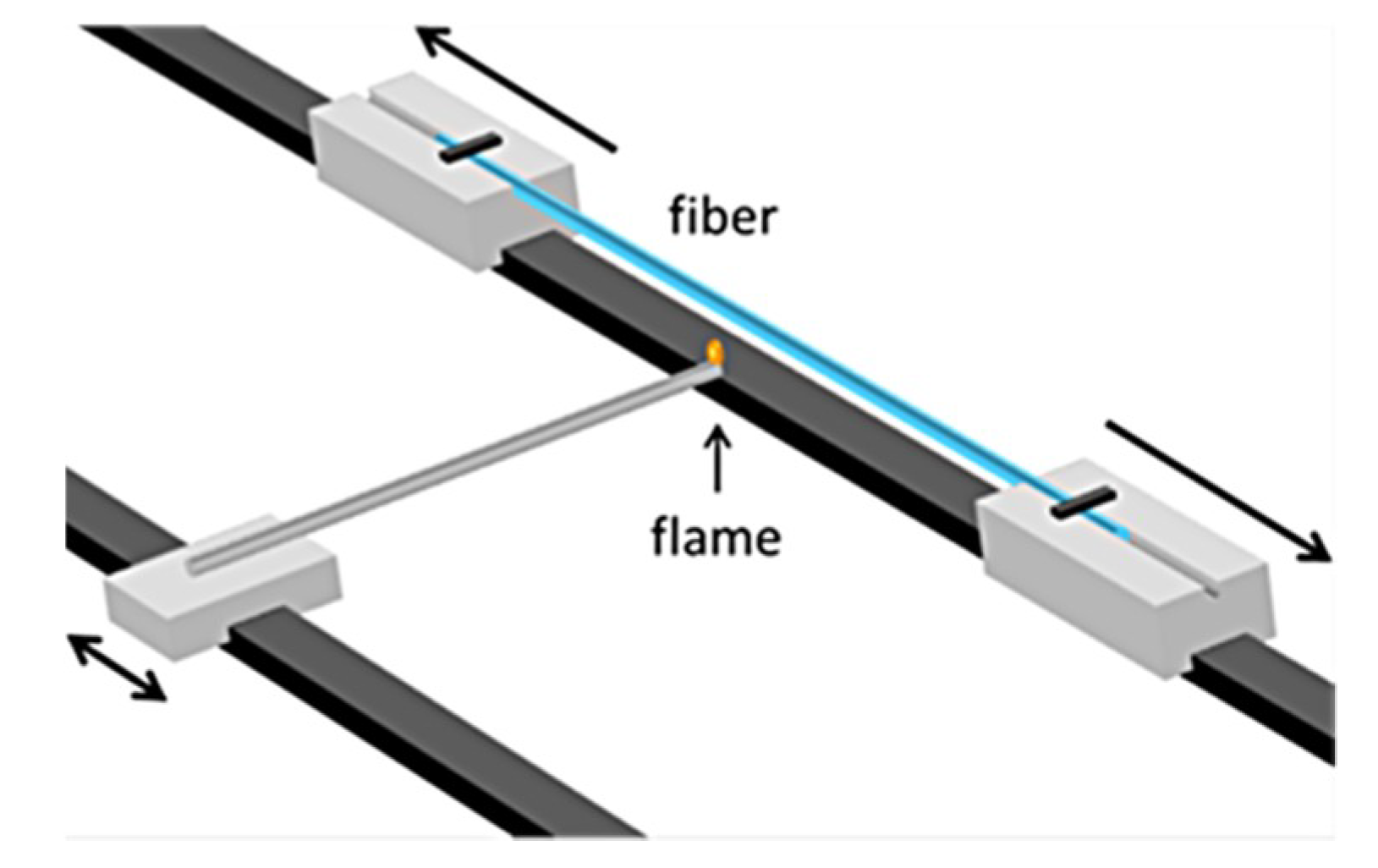
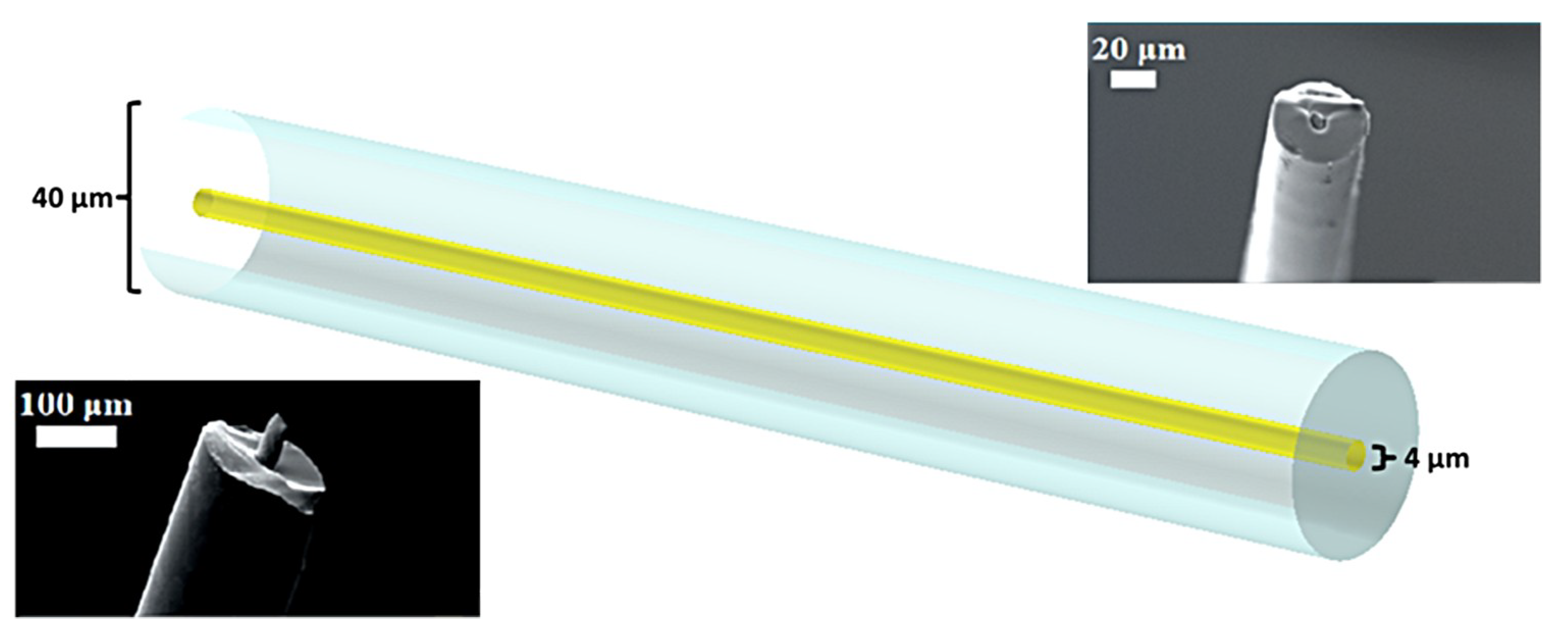
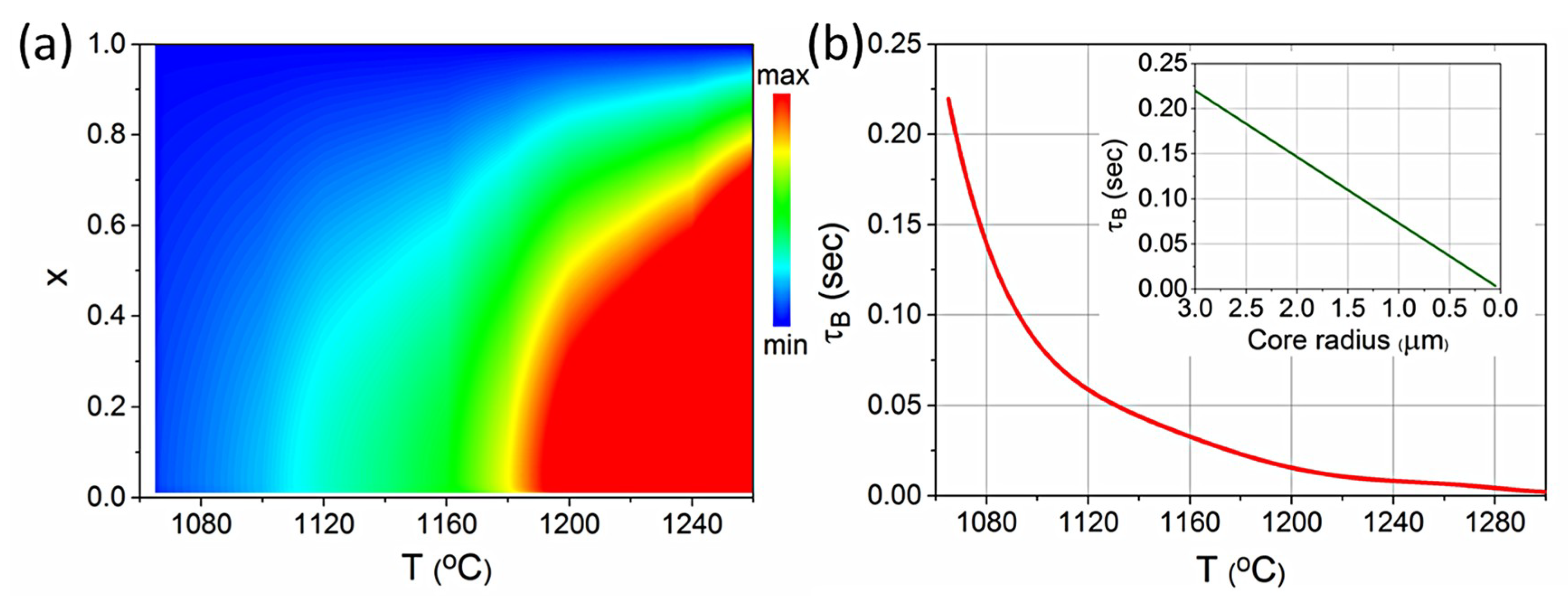

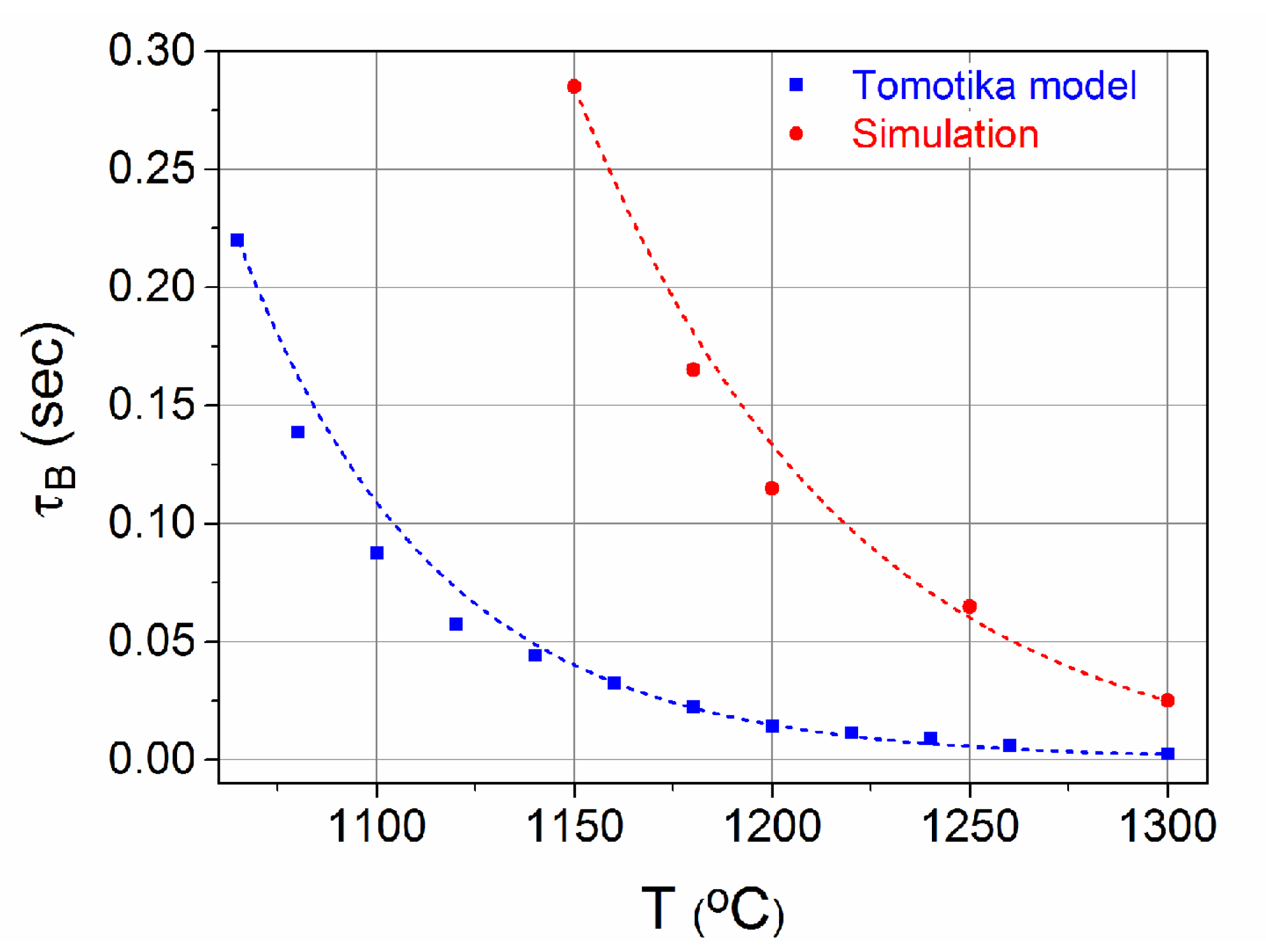
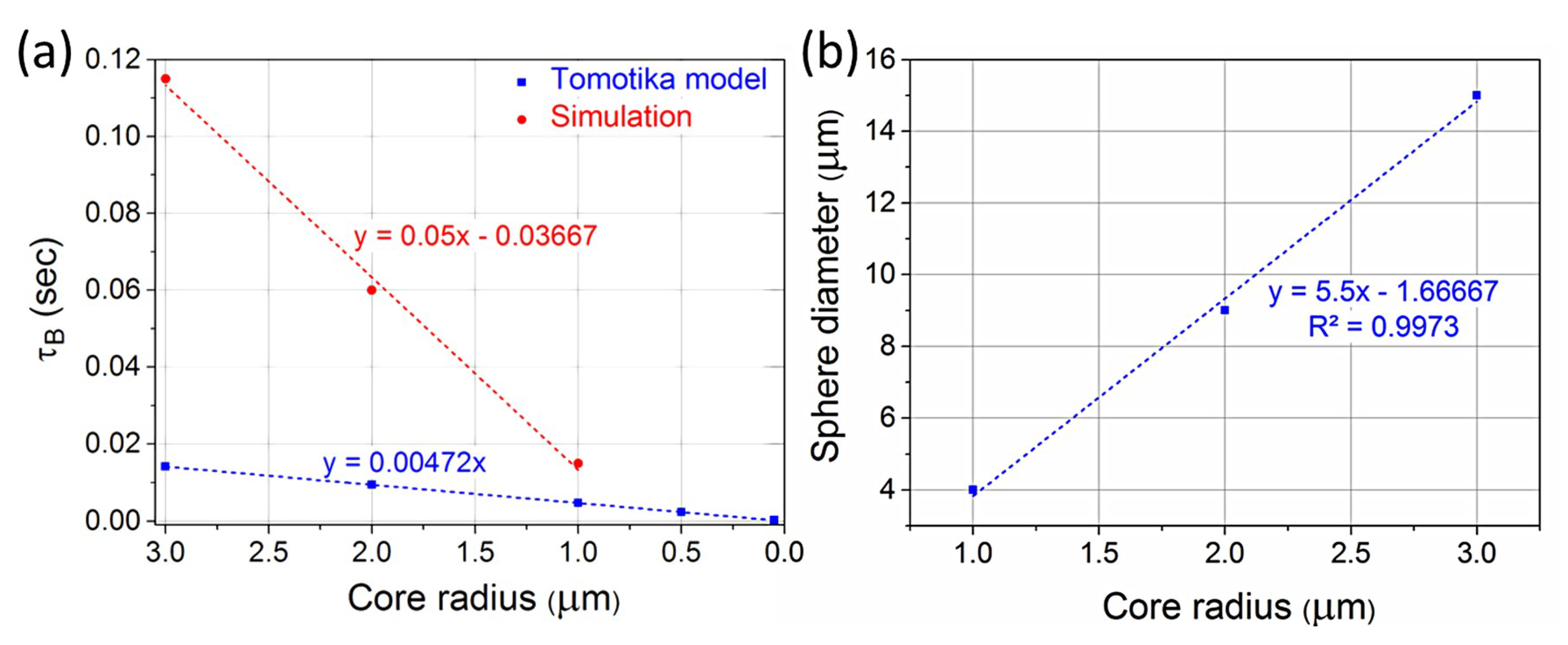




© 2019 by the authors. Licensee MDPI, Basel, Switzerland. This article is an open access article distributed under the terms and conditions of the Creative Commons Attribution (CC BY) license (http://creativecommons.org/licenses/by/4.0/).
Share and Cite
Petropoulou, A.; Drikakis, D.; Riziotis, C. Microspheres Formation in a Glass–Metal Hybrid Fiber System: Application in Optical Microwires. Materials 2019, 12, 1969. https://doi.org/10.3390/ma12121969
Petropoulou A, Drikakis D, Riziotis C. Microspheres Formation in a Glass–Metal Hybrid Fiber System: Application in Optical Microwires. Materials. 2019; 12(12):1969. https://doi.org/10.3390/ma12121969
Chicago/Turabian StylePetropoulou, Afroditi, Dimitris Drikakis, and Christos Riziotis. 2019. "Microspheres Formation in a Glass–Metal Hybrid Fiber System: Application in Optical Microwires" Materials 12, no. 12: 1969. https://doi.org/10.3390/ma12121969




